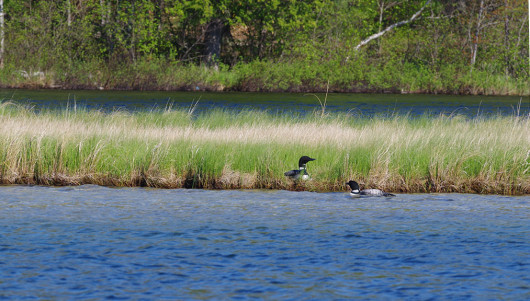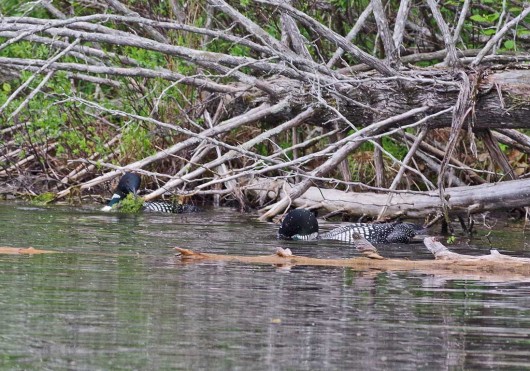 This pair of Common Loons is nesting on the west side of the island that’s near the public access. Kudos to them this year for picking a pretty good spot. Usually the nest is on the east side of the island, where there’s a constant flow of boats coming and going. This island is close to the shore. So it seems like a determined dog or raccoon with a taste for eggs could wreck havoc on the nest. But it’s been a successful spot for them in the past. Once the eggs are laid, and there will only be 1 or 2 of them, the chicks hatch in 26 to 29 days.
This pair of Common Loons is nesting on the west side of the island that’s near the public access. Kudos to them this year for picking a pretty good spot. Usually the nest is on the east side of the island, where there’s a constant flow of boats coming and going. This island is close to the shore. So it seems like a determined dog or raccoon with a taste for eggs could wreck havoc on the nest. But it’s been a successful spot for them in the past. Once the eggs are laid, and there will only be 1 or 2 of them, the chicks hatch in 26 to 29 days.
Long Lake’s “Loon Ranger” has set out a buoy letting everyone know to steer clear of the nest. Loons need us to leave them alone while they’re nesting. If loons are poking their head up from the nest in an alert position, or if they are squashed down with their head low to the water–those are signs we’re too close. And if they leave the nest or if their mate is nearby vocalizing, they’re telling us to move further away.
Long Lakers are pretty good about giving “our” loons lots of space to do their thing. And we pretty much do what’s right. But, just in case you need to remind anyone to leave the loons alone, they are migratory birds and that means they’re protected by the Federal Migratory Bird Act. The Act prohibits the harassment or killing of loons or chicks (or messin’ with their eggs…OK, the Act doesn’t put it exacty that way). It’s also illegal to possess loon feathers, eggs, nests, or entire birds.
The male loon selects the nest site. He may select the same nest the pair used the year before, just spruced up a bit. The pair will build the nest together, usually in late May or early June. They’ll mound up dead plant material and then smooth out a bowl shape with their bodies. The nest will be right on the water’s edge so that the loon can basically have an underwater approach to the nest.
This next pair was busy building their nest in Ghost Bay on May 24th, just north of the beaver lodge. They were both pulling up mouthfulls of gunk and weeds from the lake bottom and tossing it on the shore. You can see one of them with his beak stuffed with foliage. But they seem to have abandoned the effort. It really wasn’t the best spot anyway. Hopefully they will find their way back to Belly Button Island, where so many loons have successfully nested in the past.
We’re hoping this second pair of loons get their nesting act together soon.
And let’s not talk about the Canada Geese. We spent the weekend chasing them off our lawn. Three pair. One with two goslings left from their brood. One with five goslings growing like a house afire. And one pair with twelve (that’s not a typo) twelve goslings all in full eat-the-grass and poop-out-the-green-tootsie-rolls mode. We’re bringing out the coyote decoy. But it won’t work. It never does. Still, I keep trying. Headley, the gator decoy never worked either. This past weekend, I tried barking at them from inside the house. Good thing our immediate neighbors weren’t around to hear me.











